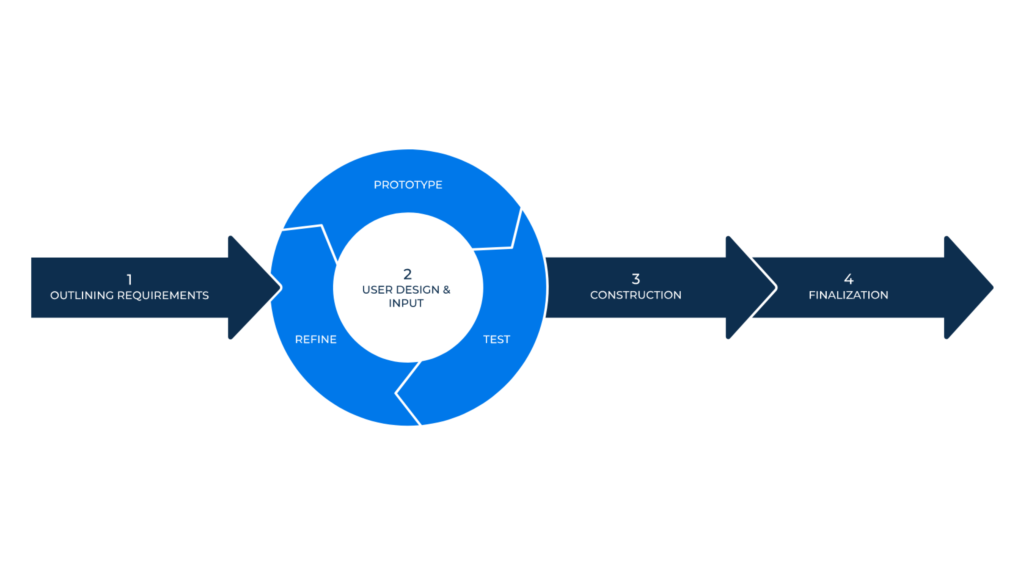
Rapid Application Development: A Closer Look
Rapid Application Development (RAD) is a methodology that allows businesses to efficiently and flexibly develop projects, enabling them to test functionality without disrupting their production pipeline. The ability to quickly release bug-free projects has long been a challenge for businesses, particularly in fast-paced industries where customer requirements constantly shift. In this article, we will explore the definition of RAD, its benefits, and how it can be applied to your next project.
Introduction
Rapid Application Development (RAD) is a development model that prioritizes rapid prototyping and quick, constructive feedback in the production pipeline.
Background: The concept of RAD was first introduced in 1991 by James Martin, although Barry Boehm developed the RAD process as the spiral model.
Essential Facet: The critical aspect of this process is the user design and input phase, where the end-user and business continuously interact to modify and improve the working model before full-on application development. By focusing on prototyping in the user design phase, companies can adapt to new knowledge and better align with the users and their requirements.
Benefits: By involving the end-user in the development process, businesses can avoid developing products that fail to fulfil the desired outcome. Further changes in the end product often lead to redesign and redevelopment, subjecting the project and its owners to increased cost and a pushed timeline.
Comparison: In contrast to the RAD model, the waterfall model is better for projects with sequential steps and precise, set requirements. RAD presents itself as a solution instead of the rigid process models laid out by the waterfall model.
Why Is Rapid Application Development (RAD) Important?
One of the critical features of RAD is that it allows the end-user to guide the development process. Instead of relying solely on the team’s preconceived knowledge to define the specifications of a project, RAD incorporates knowledge gained during the project and adapts the final product to fit these new learnings.
Advantages Of RAD:
Risk Reduction: Employing early-stage prototyping through a RAD approach reduces implementation risks, such as going over budget or creating vulnerabilities and bugs in the code. A thorough documentation of solutions and associated risks is created during the initial planning stage, allowing development teams to find and implement creative solutions before release.
User Involvement: Constant feedback from end-users improves the quality of the final product. Incorporating client feedback reduces the risk of creating a feature-packed product that no one wants. Effective communication within the team is crucial for this stage.
Efficient Project Completion: Traditional methodologies like waterfall projects are often prone to setbacks due to catastrophic failures at development time. RAD addresses this issue by focusing on prototyping and addressing problems from different angles and perspectives at an earlier stage, resulting in meeting project timelines and staying within the budget.
The Pros And Cons Of Rapid Application Development (RAD)
Pros:
- Requirements can be changed at any time
- Encourages and prioritizes customer feedback
- Development time is drastically reduced
- The short time between prototypes and iterations
- Integration is seamless from project inception
- RAD techniques make it easier to deal with budgetary constraints
Cons:
- Strong team collaboration is required
- Not suitable for large teams
- User requirements are necessary throughout the product’s life cycle
- More complex to manage compared to other models
- Only systems that can be modularized can be developed using RAD
- Projects must fit within certain constraints to properly utilize a RAD development approach
How Does Rapid Application Development Work?

The four main stages of the entire process for the Rapid Application Development model are as follows:
Step 1: Outlining requirements In this stage, the client, business owners, project managers, and software developers work together to outline the project’s needs. This planning phase involves researching the current problem and defining the project requirements, with the understanding that they may change.
Step 2: User design and input This stage involves creating system testing, working prototypes, and beginning construction. The business continuously collects client feedback to ensure that the requirements are met. Feedback is then implemented into the beta system and submitted for further feedback.
Step 3: Construction The rapid construction phase takes the prototypes and existing beta systems created with user input and converts them into the final product. User feedback remains essential during this phase to build an easily-approved product.
Step 4: Finalization In this stage, the final working model is released. Testing the data flow and interfaces that the end user will interact with and finishing touches like user training, conversion and interface testing is done in this step. The goal is to develop efficient, cost-effective large-scale projects by constantly creating incremental improvements and rolling out relevant updates.
When Is The Best Time To Use The Rapid Application Development Methodology?
The RAD model is an ongoing development process focusing on incremental improvements through rapid prototype development and user testing. It is suitable for most software development projects, but here are some specific situations where it is beneficial:
When user testing is easily accessible, The RAD process is most effective when you have direct access to the end users. Prototypes developed using the RAD model rely on feedback from previous iterations, so having a reliable source of feedback is crucial.
While RAD projects are relatively inexpensive when the budget is a consideration, the back-and-forth between the end-user and project builder and prototyping may create an endless loop of development and review. This can push the project timeline further and increase costs if not managed properly. Hiring experienced RAD developers can help keep costs down while meeting tight deadlines.
When time is of the essence, Experienced RAD teams can create quality products while meeting tight deadlines. The on-the-fly approach used in RAD models allows for improvements as user feedback is received, reducing the risk of rebuilding the model plan from scratch.
Improve Your Software Product
Rapid Application Development (RAD) is an agile approach that prioritizes speed and flexibility. This method focuses on making multiple iterations and updates throughout the development process, allowing teams to adapt quickly to changing project requirements. This iterative approach helps to ensure customer satisfaction by constantly incorporating feedback and revisions. This method is perfect for businesses dealing with software and technology that must respond fast to customer needs changes.
Manish Surapaneni
A Visionary & Expert in enhancing customer experience design, build solutions, modernize applications and leverage technology with Data Analytics to create real value.
Other articles

Manish Surapaneni
Stop Outsourcing Your Ethics, Tech Leaders
Setting up their own ethics committee is a step forward for tech companies, as they are the clear winners of

Manish Surapaneni
How To Beat The Tech Talent Squeeze In 2023: 6 Proven Strategies
In the current economic climate, with rising costs and increased job turnover, one of the biggest mistakes a company can

Manish Surapaneni
How Augmented Human Intelligence Can Enhance Our Lives With Machines
The advancement of technology has simplified our lives. It has also significantly increased our reliance on electronic devices. MIT Media